Kingdom Animalia Order Artiodactyla Family Delphinidae Scientific name Sousa chinensis Rank Species | Phylum Chordata Infraorder Cetacea Genus Sousa Higher classification Humpback dolphin | |
 | ||
Similar Humpback dolphin, Amazon river dolphin, Baiji, Mammal, Oceanic dolphin | ||
Chinese white dolphin
The Chinese white dolphin is a variety of Indo-Pacific humpbacked dolphin (Sousa chinensis; Chinese: 中華白海豚; pinyin: Zhōnghuá bái hǎitún). This variety inhabits the eastern portion of the species range, in Southeast Asia and Australia. Some biologists regard the Chinese white dolphin as a separate subspecies, Sousa chinensis chinensis, from the Plumbea-type Indo-Pacific humbacked dolphin, which lives in the western part of the species range, from east Africa to India. However, DNA testing has indicated that the Chinensis-type dolphins from Southeast Asia are more closely related to the Plumbea-type dolphins than they are to the Chinensis-type dolphins from Australia.
Contents
- Chinese white dolphin
- Hong kong s chinese white dolphins construction and new runway threat
- Behavior
- Reproductive cycle
- Humans and the environment
- Dolphin watching
- Cantonese slang
- Eastern Taiwan Strait ETS population
- Conservation
- Timeline of main events
- References
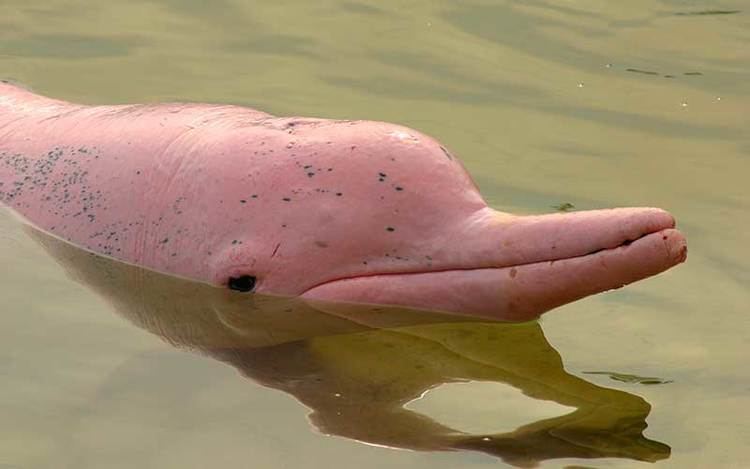
An adult Chinese white dolphin is white or pink and may appear as an albino dolphin to some. Uniquely, the population along the Chinese coast has pink skin, and the pink colour originates not from a pigment, but from blood vessels which were overdeveloped for thermoregulation. The body length is 2 to 3.5 m (6 ft 7 in to 11 ft 6 in) for adults 1 m (3 ft 3 in) for infants. An adult weighs 150 to 230 kg (330 to 510 lb). Chinese white dolphins live up to 40 years, as determined by the analysis of their teeth.
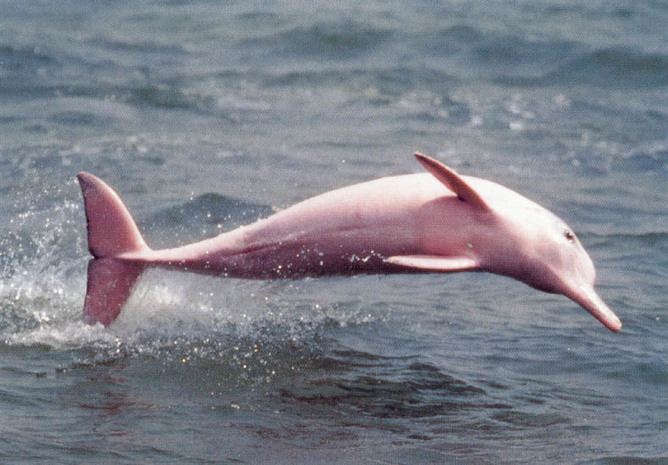
At birth, the dolphins are black. They change to grey, then pinkish with spots when young. Adults are white.
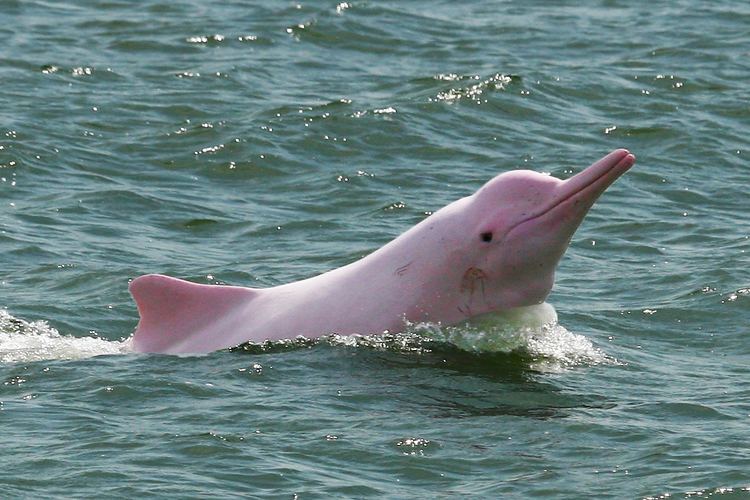
Hong kong s chinese white dolphins construction and new runway threat
Behavior
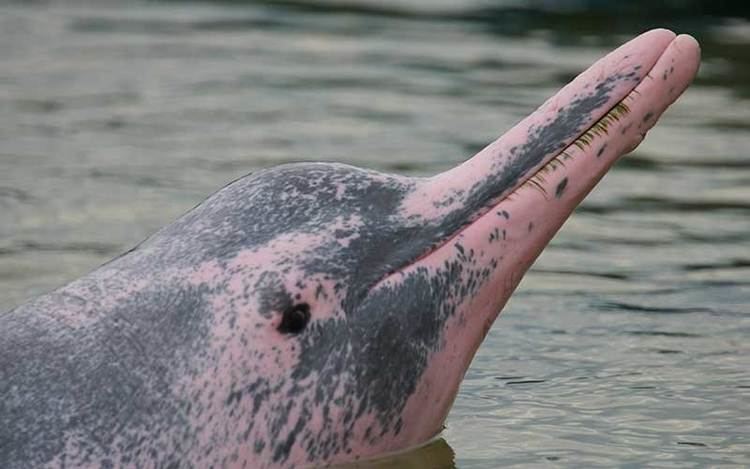
Chinese white dolphins rise to the water surface to breathe for 20 to 30 seconds and after that, they will dive into deep water again. A calf dolphin surfaces from the water twice as much as an adult, because calves have smaller lung capacities than adults. Adult dolphins can stay underwater for about two to eight minutes, but a calf can only stay underwater for one to three minutes. Adult dolphins rarely stay under water for more than four minutes. They sometimes leap completely out of the water. They may also rise up vertically from the water, exposing the dorsal half of their bodies. A pair of protruding eyes allows them to see clearly in both air and water.
Reproductive cycle
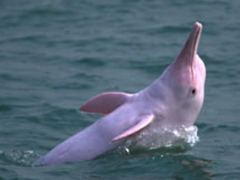
Chinese white dolphins are sociable creatures and live in groups of three to four. Female white dolphins become mature at 10 years old, while the males become mature at 13 years old. They usually mate from the end of summer to autumn. Infant dolphins are usually born 11 months after the mating. Mature females can give birth every three years, and the parental care will last until their offspring can find food themselves.
Humans and the environment
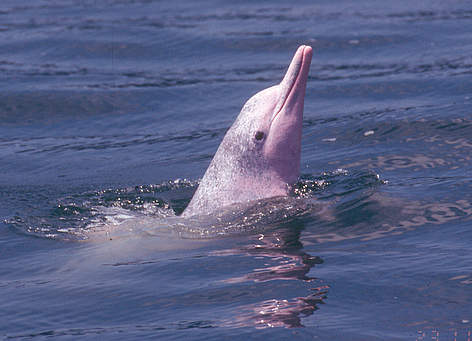
The white dolphin has been threatened, mostly by China's pollution. Conservationists warned that Hong Kong may lose its rare Chinese white dolphins, also known as pink dolphins for their unique colour, unless it takes urgent action against pollution and other threats. Their numbers in Hong Kong waters have fallen from an estimated 158 in 2003 to just 78 in 2011, with a further decline expected when figures for 2012 are released next month, said the Hong Kong Dolphin Conservation Society. "It is up to the government and every Hong Kong citizen to stand up for dolphins. We risk losing them unless we all take action," said society chairman Samuel Hung. A tour guide from Hong Kong Dolphinwatch spotted a group of pink dolphins helping a grieving mother support the body of her dead calf above the water in an attempt to revive it. The scene, captured on video and widely shared on Facebook, has raised fresh concerns about the dwindling population in a city where dolphin watching is a tourist attraction. "We’re 99 percent certain the calf died from toxins in the mother’s milk, accumulated from polluted seawater," said Hong Kong Dolphinwatch spokeswoman Janet Walker, who added it was the third such incident reported in April alone. Fewer than 2,500 of the mammals survive in the Pearl River Delta, the body of water between Macau and Hong Kong, with the majority found in Chinese waters and the rest in Hong Kong.
Dolphin watching
Hong Kong Dolphinwatch has been running boat trips to visit the Chinese white dolphins for the past 12 years. The dolphins mainly live in the waters of Lantau North, Southeast Lantau, the Soko Islands and Peng Chau. The trips are done primarily with the purpose of raising awareness amongst Hong Kong residents regarding the dolphins, and the operation strictly adheres to the code of conduct for dolphin-watching activities. Ten percent of the profits of the organization goes into research for Friends of the Earth (HK)'s Water Action Group, which is a charity aimed to raise public awareness of Hong Kong's coastal environment.
There have been some recent reports of dolphin watching practices that have further endangered the Chinese white dolphins, such as in Sanniang Bay in Qinzhou and off Xiamen. However, these generally are small, locally organised one-off tours or private pleasure boats that do not adhere to the Hong Kong Agricultural and Fisheries Department's voluntary code of conduct. The basic principles of these codes of conduct are to always observe the dolphins from a distance, and to not attempt to physically contact, feed or harm the dolphins. Additionally, boats should maintain a slow and steady speed, not exceeding 10 knots, and the boat should always maintain a parallel movement to the dolphin's course.
Population in Leizhou Bay, Leizhou Peninsula, holding nearly 1,000 animals and is the second largest of local populations in the nation, may also be targeted for future tourism.
Nánpēng Islands Marine Sanctuary in Nan'ao County, Hepu National Sanctuary of Dugongs, and waters around Sanya on Hainan Island are home to certain number of dolphins.
Cantonese slang
The Cantonese language has a slang expression wu gei bak gei (often written as 烏忌白忌, "black taboo white taboo") which means someone or something is a bad omen or a nuisance. The phrase originates from the Cantonese fisher people, because they claim the dolphins eat the fish in their nets. However, in formal Chinese, it should be written as 烏鱀白鱀, with the gei originally in olden Chinese, meaning dolphins. The wu refers to the finless porpoises, which are black, and the bak, white, referring to Chinese river dolphins. These two species often interrupt and ruin the fishermen's catch. As years passed, because "dolphin" sounds the same as "bad luck", the meaning of the phrase changed. However, in Cantonese, wu refers to the calves of Chinese white dolphin and bak refers to the adults. Nowadays, dolphins are not called gei anymore, but 海豚 (hoi tuen), literally meaning "sea pig", with none of the negative connotations for pig unlike in English.
Eastern Taiwan Strait (ETS) population
The Indo-Pacific humpback dolphins were first discovered along the west coast of Taiwan in 2002. Based on a survey done in 2002 and 2003, they are often found in waters <5m deep, and no evidence shows that they appear in water deeper than 15m. A study in 2008 found that the population of humpback dolphins, which occupies a linear range of about 500 km^2 along the central west coast of Taiwan, is genetically distinct from all populations living in other areas. And this population is called Eastern Taiwan Strait (ETS) population.
Taiwan is a densely populated island and highly developed country, which has many industrial development projects, especially along the west coast, where the ETS populations of Indo-Pacific humpback dolphins live. Based on data collected between 2002 and 2005, the ETS population of humpback dolphins was less than 100 individuals. Unfortunately, the newest data released in 2012 shows that only 62 individuals are left. It means during those 7 years, population of humpback dolphins is being destroyed constantly and severely. A preliminary examination revealed that the ETS humpback dolphin population meets the IUCN Red List criteria for "Critically Endangered". Without further protection and regulation, this population will go extinct quickly.
There are several facts that result in the decreasing number of ETS population of humpback dolphins. First, large-scale modification of the shoreline by industrial development including hydraulic filling for creating industrial or science parks, seawall construction and sand mining cause habitat fragmentation and diminish dolphin’s habitats. In addition, exploitation of shoreline also contributes to toxic contamination flows into dolphin’s habitats. The chemical pollution from industrial or agricultural and municipal discharge results in impaired health of dolphins, for instance, reproductive disorders, and compromised immune system.
Second, fishing activities along the west coast of Taiwan are thriving, and cause many impacts on dolphins. Widespread and intensive use of gillnets and vessel strikes are potential threats for dolphins. Over exploitation of fish by fisheries’ is another threat for the dolphin population. It has led to disturbance of marine food web or trophic level and reduces marine biodiversity. Therefore, dolphins have not enough prey to live on.
Still another problem is reduced amount of freshwater flows into estuaries from rivers. Since ETS population of humpback dolphins is closely associated with estuaries habitat, the elimination of freshwater discharge from rivers significantly decreases the amount of suitable habitats for dolphins.
Hydroacoustic disturbance is another critical issue for dolphins. Sources of noise can come from dredging, pile driving, increased vessel traffic, seawall construction, and soil improvement. For all cetaceans, sound is vital for providing information about their environment, communicating with other individuals, and foraging; also, they are very vulnerable and sensitive to the effects of noise. Elevated anthropogenic sound level causes many dysfunctions of their behaviors, and even leads to death.
In addition to threats from anthropogenic activities, dolphins are potentially at the risk due to the small population size, which may result in inbreeding and decreased genetic and demographic variability. Finally, climate change causes more typhoons to hit the west coast of Taiwan and cause great disturbance to dolphins’ habitats.
Conservation
The Indo-Pacific humpback dolphin is listed on Appendix II of the Convention on the Conservation of Migratory Species of Wild Animals (CMS). It is listed on Appendix II as it has an unfavourable conservation status or would benefit significantly from international co-operation organised by tailored agreements. In the interim of 2003–2013, the number of these dolphins in the bay around Hong Kong has dwindled from a population of 159 to just 61 individuals, a population decline of 60% in the last decade. The population continues to be further threatened by pollution, vessel collision, overfishing, and underwater noise pollution.
The Indo-Pacific humpback dolphin is also covered by the Memorandum of Understanding for the Conservation of Cetaceans and Their Habitats in the Pacific Islands Region (Pacific Cetaceans MoU).
